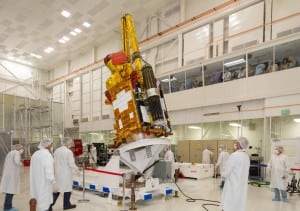Latest News

The spacecraft being prepared for shipment to Vandenberg Air Force Base by the team at the Jet Propulsion Lab. The lightweight and compact AstroMesh reflector and boom assembly are stowed in preparation for launch. Photo: Northrop Grumman
[Via Satellite 01-05-2015] To enable NASA’s Soil Moisture Active Passive (SMAP) mission to meet its accuracy needs while covering the globe every three days or less, SMAP engineers at NASA’s Jet Propulsion Laboratory in Pasadena, Calif. designed and built the largest rotating antenna that could be stowed into a space of only 1 foot by 4 feet for launch on Jan. 29. The dish is 19.7 feet in diameter. SMAP will measure the moisture lodged in Earth’s soils with high accuracy and resolution. The instrument’s three main parts are a radar, a radiometer and the largest rotating mesh antenna ever deployed in space.
The antenna is attached on one side to an arm with a crook in its elbow. It spins around the arm at about 14 revolutions per minute. Northrop Grumman provided the antenna dish. The motor that spins the antenna was provided by Boeing.
SMAP’s radar, developed and built at JPL, uses the antenna to transmit microwaves toward Earth and receive the signals that bounce back, called backscatter. The microwaves penetrate a few inches or more into the soil before they rebound. Changes in the electrical properties of the returning microwaves indicate changes in soil moisture, and also tell whether or not the soil is frozen.
SMAP’s radiometer detects differences in Earth’s natural emissions of microwaves that are caused by water in soil. The problem is radio frequency interference. The microwave wavelengths that SMAP uses are officially reserved for scientific use, but signals at nearby wavelengths that are used for air traffic control, cell phones and other purposes spill over into SMAP’s wavelengths unpredictably. Conventional signal processing averages data over a long time period, which means that even a short burst of interference skews the record for that whole period. The Goddard engineers devised a new way to delete only the small segments of actual interference, leaving much more of the observations untouched.
Combining the radar and radiometer signals allows scientists to take advantage of the strengths of both technologies while working around their weaknesses. “The radiometer provides more accurate soil moisture but a coarse resolution of about 40 kilometers [25 miles] across,” said JPL’s Eni Njoku, a research scientist with SMAP. “With the radar, you can create very high resolution, but it’s less accurate. To get both an accurate and a high-resolution measurement, we process the two signals together.”
Get the latest Via Satellite news!
Subscribe Now